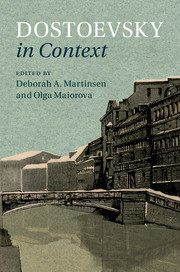Book contents
- Frontmatter
- Contents
- List of illustrations
- Notes on contributors
- Acknowledgments
- Note on citation, transliteration, glossary, and dates
- Chronology
- 1 Introduction: the many worlds of Dostoevsky
- PART I SOCIAL, HISTORICAL, AND CULTURAL CONTEXTS
- i CHANGING POLITICAL, ECONOMIC, AND SOCIAL LANDSCAPE
- ii POLITICAL, SOCIAL, AND CULTURAL INSTITUTIONS
- iii SPACE AND PLACE
- 18 Symbolic geography
- 19 St. Petersburg
- 20 The Crystal Palace
- iv RELIGION AND MODERNITY
- PART II LITERATURE, JOURNALISM, AND LANGUAGES
- Glossary
- Further reading
- Index
- References
20 - The Crystal Palace
from iii - SPACE AND PLACE
Published online by Cambridge University Press: 18 December 2015
- Frontmatter
- Contents
- List of illustrations
- Notes on contributors
- Acknowledgments
- Note on citation, transliteration, glossary, and dates
- Chronology
- 1 Introduction: the many worlds of Dostoevsky
- PART I SOCIAL, HISTORICAL, AND CULTURAL CONTEXTS
- i CHANGING POLITICAL, ECONOMIC, AND SOCIAL LANDSCAPE
- ii POLITICAL, SOCIAL, AND CULTURAL INSTITUTIONS
- iii SPACE AND PLACE
- 18 Symbolic geography
- 19 St. Petersburg
- 20 The Crystal Palace
- iv RELIGION AND MODERNITY
- PART II LITERATURE, JOURNALISM, AND LANGUAGES
- Glossary
- Further reading
- Index
- References
Summary
From the moment of its construction, London's Crystal Palace (Fig. 4), the iron and glass structure designed by Joseph Paxton for the 1851 Great Exhibition in Hyde Park and subsequently moved to Sydenham Hill in South London, where it stood until its destruction by fire in 1936, was subject to intense international interest and viewed as a symbol of modernity. It also became the central image of Dostoevsky's critique of western rationalism, particularly of the radicals and their utopian aspirations. His appropriation of this symbol incorporated ideas about the Crystal Palace's all-encompassing and contradictory nature that characterized its history and reception.
From the original idea for the Great Exhibition in 1851 to its subsequent interpretation by historians, the meaning and use of the Crystal Palace has seen significant changes. The project, for the first world's fair, showcasing industry, manufactures, and applied arts from Britain and the rest of the world, was initially conceived as a means of shaping the image of Britain and the British Empire for the Victorian era (and, equally, of defining the image of the non-Western “other”); of promoting free trade and internationalism (and, therefore, global peace); of proclaiming the superiority of British manufactures; of defining, celebrating, and educating people about industry, manufacturing processes and products; and of bringing together different classes and cultures. Beyond the immediate designs of the royal commission that established the Great Exhibition, the palace led to material changes in Britain's infrastructure and cultural life, as the success of the Great Exhibition resulted in the establishment in London of the Science, Natural History, and Victoria and Albert Museums, Imperial College, and the Royal Albert Hall. The palace also played a crucial role not simply in representing, but in defining the very meaning of modernity, both in terms of its aesthetic form, and in relation to the changes in knowledge and behavior that modernity introduced. In particular, the Crystal Palace has been associated with concepts of the “general public” and of consumerism as spectacle.
The function and aims of the reconstructed palace, which opened in Sydenham in 1854, were somewhat different. The educational focus switched from industry to the cultures of different civilizations, as visitors walked through architectural courts that took them on a trip around the world and through the ages.
- Type
- Chapter
- Information
- Dostoevsky in Context , pp. 176 - 184Publisher: Cambridge University PressPrint publication year: 2016



